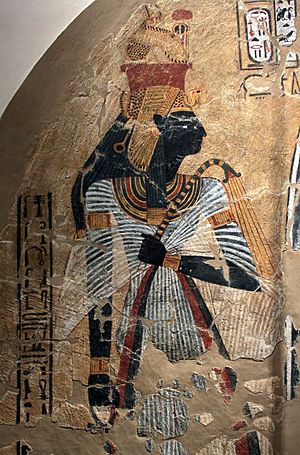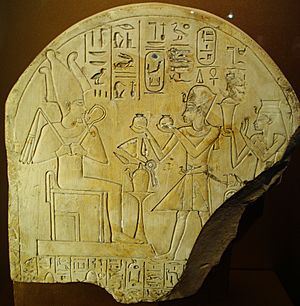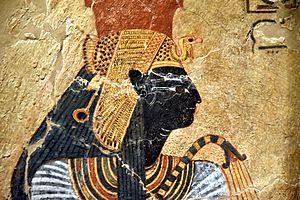Ahmose-Nefertari facts for kids
Quick facts for kids Ahmose-Nefertari |
|||||
|---|---|---|---|---|---|
| Queen consort of Egypt Great Royal Wife God's Wife of Amun Regent |
|||||

Ahmose Nefertari as depicted in tomb TT359
|
|||||
| Spouse | Ahmose I | ||||
| Issue | Amenhotep I Ahmose-ankh Siamun Ramose ? Ahmose-Meritamun Mutnofret ? Ahmose-Sitamun |
||||
|
|||||
| Dynasty | 18th Dynasty | ||||
| Father | Seqenenre Tao | ||||
| Mother | Ahhotep I | ||||
| Religion | Ancient Egyptian religion | ||||
| Ahmose-Nefertari in hieroglyphs | ||||||||||||
|---|---|---|---|---|---|---|---|---|---|---|---|---|
Ahmose Nefertari Jꜥḥ ms Nfr trj Born of Iah, the beautiful companion |
||||||||||||
Ahmose-Nefertari was a powerful queen of Ancient Egypt. She was the first Great Royal Wife of the 18th Dynasty. Her parents were Seqenenre Tao and Ahhotep I. She married her brother, Ahmose I, who became pharaoh. Their son, Amenhotep I, later became pharaoh. Ahmose-Nefertari might have ruled as a regent for him when he was young. After her death, she was honored as a goddess.
Contents
Family Life
Ahmose-Nefertari was the daughter of Seqenenre Tao and Ahhotep I. Her grandmother was Queen Tetisheri. Ahmose-Nefertari was born in Thebes, a major city in ancient Egypt. She had many brothers and sisters. Her husband, Ahmose I, was also her brother.
She and Ahmose I had several children. Their sons included Ahmose-ankh and Siamun. Their most famous son was Amenhotep I, who became the next pharaoh. They also had daughters, Ahmose-Meritamun and Ahmose-Sitamun, who became royal wives.
Her Life as Queen
Ahmose-Nefertari was born during a time when Egypt was fighting against invaders called the Hyksos. Her father, Seqenenre Tao, fought against them and may have died in battle.
Her husband, Ahmose I, became pharaoh when he was very young. His mother, Ahhotep I, ruled as a regent for him. Ahmose I became the first king of the 18th Dynasty. He reunited Egypt after the Hyksos were defeated.
Queen Ahmose-Nefertari held many important titles. These included "Great King's Wife" and "God's Wife of Amun." This last title was very special. It meant she was in charge of temple properties, money, and staff. She was seen as a very important religious figure. People even called her "Goddess of Resurrection."
When her son, Amenhotep I, became pharaoh, he was also young. Ahmose-Nefertari likely helped him rule as his regent. Some people think she might have even started the famous Valley of the Kings, where pharaohs were buried.
Ahmose-Nefertari lived into the early years of the next pharaoh's rule, Thutmose I. She is shown in carvings with him, which means she was still alive and important.
Death and Becoming a Goddess
Ahmose-Nefertari probably died around the fifth or sixth year of Thutmose I's reign. An ancient text says that she "flew to heaven." She was likely buried in a place called Dra Abu el-Naga.
After her death, Ahmose-Nefertari was honored as a goddess. People called her "Mistress of the Sky" and "Lady of the West." She was especially important to the workers who built the royal tombs in Deir el-Medina.
Her Mummy
Ahmose-Nefertari's mummy was found in a secret burial place called DB320. This was a hiding spot for many royal mummies. Her body was unwrapped in 1885. She was likely in her 70s when she died. Like her grandmother, Tetisheri, her hair was thin, and false hair was added to it.
Her mummy showed some interesting features. Her skin was darkened, like many other mummies from that time. She also had very noticeable front teeth, a trait seen in her grandmother, Tetisheri. This suggests it was a family feature.
In April 2021, Ahmose-Nefertari's mummy was moved to the National Museum of Egyptian Civilization. This was part of a big event called the Pharaohs' Golden Parade.
How She Was Shown in Art
Ahmose-Nefertari is shown in many tombs and on many objects, especially in the area of Deir el-Medina. She is often shown wearing a special headband with two uraei (cobra symbols). This became a common symbol for queens after her.
In some artworks, Ahmose-Nefertari's skin is shown as dark, sometimes black or purplish-black. This was not meant to show her actual skin color. Instead, the color black was symbolic. It represented things like:
- Fertility and rebirth
- The fertile land of Egypt
- The underworld and death, which were linked to new life
Sometimes, her skin is shown in other colors like pink, gold, blue, or red. Blue skin could symbolize water and the heavens. Red skin could symbolize life or a higher status. These colors all had special meanings in ancient Egyptian art.
See also
 In Spanish: Ahmose-Nefertari para niños
In Spanish: Ahmose-Nefertari para niños





